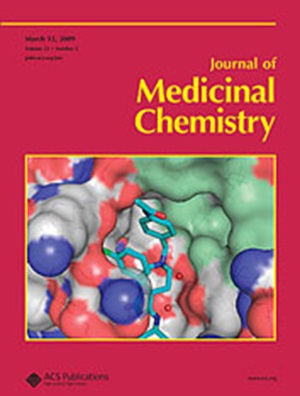极性调谐脂滴特异性探针用于心力衰竭成像。
IF 6.8
1区 医学
Q1 CHEMISTRY, MEDICINAL
引用次数: 0
摘要
心力衰竭是大多数心血管疾病的最终发展趋势,预后不良会导致严重后果。近年来,脂滴(ld)在心血管发病中的作用已得到越来越多的科学认识。ld的异常极性改变可能破坏脂质代谢平衡,这与HF的发生和发展有机制联系。在这项研究中,我们利用BODIPY支架设计和合成了探针WT-X。BODIPY是一种极性敏感的分子工具,具有供体-π-受体(D-π-A)结构框架,具有良好的光稳定性、良好的生物相容性和高度的极性选择性。WT-X对HF心肌细胞模型、炎症活斑马鱼卵黄囊区以及HF小鼠心肌ld的异常脂滴极性变化具有灵敏的检测效果。这一发现促进了病理性脂质代谢的无创可视化,用于精确的心衰管理,实现了实时治疗效果监测和患者分层。本文章由计算机程序翻译,如有差异,请以英文原文为准。
Polarity-Tuned Lipid Droplet-Specific Probe for Heart Failure Imaging.
Heart failure (HF) is the ultimate development trend of most cardiovascular diseases, and a poor prognosis would result in serious consequences. Lately, the involvement of lipid droplets (LDs) in cardiovascular pathogenesis has garnered growing scientific recognition. Aberrant polarity alterations of LDs may destroy the balance of lipid metabolism, which is mechanistically linked to the occurrence and development of HF. In this investigation, we engineered and synthesized the probe WT-X utilizing the BODIPY scaffold, a polarity-sensitive molecular tool featuring a donor-π-acceptor (D-π-A) architectural framework, which exhibits good photostability, excellent biocompatibility, and high selectivity to polarity. WT-X demonstrated sensitive detection of aberrant lipid droplet polarity alterations in HF cardiomyocyte models, yolk sac region of inflamed live zebrafish, and the myocardial LDs in mice with HF. This discovery facilitates noninvasive visualization of pathological lipid metabolism for precision HF management, enabling real-time therapeutic efficacy monitoring and patient stratification.
求助全文
通过发布文献求助,成功后即可免费获取论文全文。
去求助
来源期刊

Journal of Medicinal Chemistry
医学-医药化学
CiteScore
4.00
自引率
11.00%
发文量
804
审稿时长
1.9 months
期刊介绍:
The Journal of Medicinal Chemistry is a prestigious biweekly peer-reviewed publication that focuses on the multifaceted field of medicinal chemistry. Since its inception in 1959 as the Journal of Medicinal and Pharmaceutical Chemistry, it has evolved to become a cornerstone in the dissemination of research findings related to the design, synthesis, and development of therapeutic agents.
The Journal of Medicinal Chemistry is recognized for its significant impact in the scientific community, as evidenced by its 2022 impact factor of 7.3. This metric reflects the journal's influence and the importance of its content in shaping the future of drug discovery and development. The journal serves as a vital resource for chemists, pharmacologists, and other researchers interested in the molecular mechanisms of drug action and the optimization of therapeutic compounds.
 求助内容:
求助内容: 应助结果提醒方式:
应助结果提醒方式:


